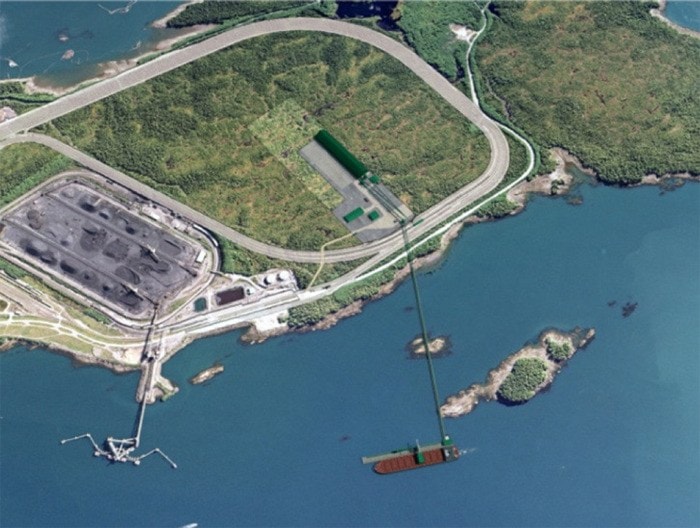Canpotex has pulled the plug on its proposed $775 million potash export terminal in Prince Rupert.
Canpotex, a partnership of three potash mining firms Agrium, Mosaic and PotashCorp (Potash Corporation of Saskatchewan), made the announcement today that the long-awaited project for Prince Rupert has been shelved.
The board of directors made the decision based on economic and commercial considerations. The company has highly efficient export terminals in Vancouver, Saint John and Portland, and Canpotex determined it has sufficient port access and terminal capacity options to meet its needs, stated the press release.
“This decision was made after careful deliberation of Canpotex’s current and anticipated terminal capacity needs, and the options we have to meet those needs” said Ken Seitz, Canpotex’s president and chief executive officer.
“We sincerely appreciate the relationships developed over the years this project was considered. We thank all project stakeholders and community members for their constructive interactions with Canpotex and interest in the project.”
Don Krusel, president and CEO of the Port of Prince Rupert, called the announcement a clear example of what may happen when opportunities are not seized when they present themselves.
"Today's announcement illustrates the ongoing challenge we face in working with proponents and developers from various industries. They invest millions of dollars and years of effort in an attempt to build infrastructure that will enable trade. At the same time, commodity markets, exchange rates, environmental activism and political pressures are in a continuous state of change. Canpotex's decision demonstrates that economic development opportunities have a limited lifespan. We need to improve our collective efforts to capitalize on these opportunities before economic windows close," Krusel said.
"It is important to acknowledge that Canpotex's long commitment to this project resulted in significant legacies to port infrastructure, including a contribution to shared rail, road and utility systems. The term of Canpotex's relationship with the Port of Prince Rupert demarcates a period of substantial growth of our project portfolio in terms of scale, sophistication and cargo diversity."
The history of the project
The announcement comes after nearly a decade of waiting and just more than a year after the completion of the Ridley Island Road, Rail and Utility Corridor (RRUC), which was built, in part, for the proposed Canpotex terminal. Canpotex provided $15 million into that $90 million project with the federal and provincial governments each providing $30 million with the Prince Rupert Port Authority picking up the rest.
RELATED: CANPOTEX SIGNS LEASE AGREEMENT WITH PRINCE RUPERT PORT AUTHORITY
Canpotex executed a lease agreement with the PRPA in October 2014 to build the terminal that was to have a 180,000 tonne potash storage building with associated conveyor and dust collection systems and a marine wharf with access trestle and causeway capable of receiving vessels of up to 180,000 dead weight tonnes.
In September 2009, Canpotex held a public forum at the Lester Centre of the Arts to discuss the terminal where it received near-unanimous support. At that time, Canpotex said they expected the terminal would be operational by 2012.
RELATED: FEDERAL ENVIRONMENT MINISTER GIVES CANPOTEX POTASH TERMINAL THE GREEN LIGHT
In 2013 — after four years of silence — Prince Rupert city council called Canpotex on the carpet demanding some sort of response.
"Out of respect to the people of Prince Rupert ... that is the decent thing to do to continue the rapport they created at the initial public forum," said then-Mayor Jack Mussallem, noting several agencies had pushed to help Canpotex through the creation of a road, rail and utility corridor on Ridley Island.
"Canpotex has the support of the City of Prince Rupert. The Government of British Columbia, the federal government and the Prince Rupert Port Authority have all pitched in to help Canpotex."
Those sentiments were echoed by Councillor Joy Thorkelson.
"We spent a lot of our political capital pushing to get that road, rail and utility corridor. It could have been used for other purposes, like a bypass road ... you can only ask for so much," she said.
RELATED: CITY OF PRINCE RUPERT LOOKING FOR ANSWERS FROM CANPOTEX
Potash prices sink
Today's decision by Canpotex to kill the plan may have begun in August 2013 when Russian firm OAO Uralkali announced its intention to pull out of the Belarusian Potash Co. (BPC) which, along with Canpotex of Saskatchewan, controls approximately 70 per cent of the potash supply in the world.
In the past, Uralkali and its Belarus partner, Belaruski, had withheld some of its production capacity from the market in order to keep prices high but, in announcing its intention, Uralkali said it planned to begin selling its full production capability of 13 million tonnes into the market.
The effect, some experts projected, is a 25 per cent drop in potash prices from $400 to $300 per tonne as supply begins to meet demand. The result would be a hard hit to pocketbook of producers and University of British Columbia economics professor James Brander told then Northern View editor Shaun Thomas that type of a hit could put the project in jeopardy.
RELATED: INTERNATIONAL DECISION PUTS PRINCE RUPERT POTASH TERMINAL PLANS IN JEOPARDY
True to the predictions, the Russian cartel's move hammered the potash market.
Potash spot prices tumbled from $468.75 U.S. in April 2012 to just $264.00 in May 2016.
Mosaic recently reported in its February 2016 quarterly report that it expects potash to continue to decrease in price and the Canadian Potash Corporation of Saskatchewan shuttered its new $2 billion New Brunswick mine that had been in production for just more than a year.
